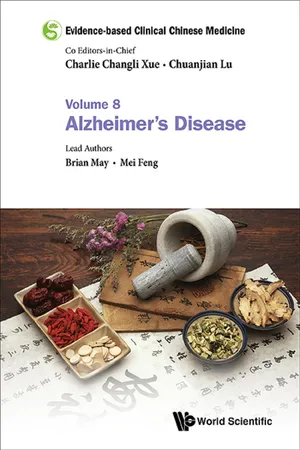
- 324 pages
- English
- ePUB (mobile friendly)
- Available on iOS & Android
About This Book
-->
The eighth volume of Evidence-based Clinical Chinese Medicine aims to provide a multi-faceted "whole evidence" analysis of the management of Alzheimer's disease in Chinese and integrative medicine.
Beginning with overviews of how Alzheimer's disease is conceptualized and managed in both conventional medicine and contemporary Chinese medicine, the authors then provide detailed analyses of how dementia and memory disorders were treated with herbal medicine and acupuncture in past eras.
In the subsequent chapters, the authors comprehensively review the current state of the clinical trial evidence for Chinese herbal medicines, acupuncture and other Chinese medicine therapies in the management of Alzheimer's disease, as well as analyse and evaluate the results of these studies from an evidence-based medicine perspective. The outcomes of these analyses are summarised and discussed in terms of their implications for the clinical practice of Chinese medicine and for future research.
This book can inform clinicians and students in the fields of integrative and Chinese medicine of the current state of the evidence for a range of Chinese medicine therapies in Alzheimer's disease, including the use of particular herbal formulas and acupuncture treatments in order to assist clinicians in making evidence-based decisions in patient care.
--> Contents:
- Introduction to Alzheimer's Disease
- Alzheimer's Disease in Chinese Medicine
- Classical Chinese Medicine Literature
- Methods for Evaluating Clinical Evidence
- Clinical Evidence for Chinese Herbal Medicine
- Pharmacological Actions of the Common Herbs
- Clinical Evidence for Acupuncture and Related Therapies
- Clinical Evidence for Other Chinese Medicine Therapies
- Clinical Evidence for Combination Therapies
- Summary and Conclusions
-->
--> Readership: Students and practitioners in alternative/Chinese medicine, neurology/neuroscience. -->
Keywords:Chinese Medicine;Chinese Herbal Medicine;Acupuncture;Alzheimer's;Dementia;MemoryReview: Key Features:
- An innovative 'whole evidence' approach: This book combines multiple types of evidence from multiple sources to provide a unique and comprehensive assessment of the available evidence for Chinese medicine in Alzheimer's disease
- Clinically informative and relevant: This book integrates the results of meta-analyses of clinical trial data with evidence from the classical Chinese medicine literature, and contemporary clinical guidelines for the application of Chinese medicine in dementia using syndrome differentiation to encompass the full scope of the clinical literature and provide matrices of the available evidence
- Developed by a skilled team: The authors are internationally recognized, well-respected leaders in the field of Chinese medicine and evidence based medicine with strong track records in research
Frequently asked questions
Information
1
Introduction to Alzheimer’s Disease
Definition of Alzheimer’s Disease
Clinical Presentation
Epidemiology of Dementia and Alzheimer’s Disease
Burden of Alzheimer’s Disease
Risk Factors
Pathological P...
Table of contents
- Cover
- Halftitle
- Title
- Copyright
- Disclaimer
- Foreword
- Purpose of The Monograph
- Authors and Contributors
- Members of Advisory Committee and Panel
- Professor Charlie Changli Xue, PhD
- Professor Chuanjian Lu, MD
- Acknowledgements
- Contents
- List of Figures
- List of Tables
- 1. Introduction to Alzheimer’s Disease
- 2. Alzheimer’s Disease in Chinese Medicine
- 3. Classical Chinese Medicine Literature
- 4. Methods for Evaluating Clinical Evidence
- 5. Clinical Evidence for Chinese Herbal Medicine
- 6. Pharmacological Actions of the Common Herbs
- 7. Clinical Evidence for Acupuncture and Related Therapies
- 8. Clinical Evidence for Other Chinese Medicine Therapies
- 9. Clinical Evidence for Combination Therapies
- 10. Summary and Conclusions
- Glossary
- Index